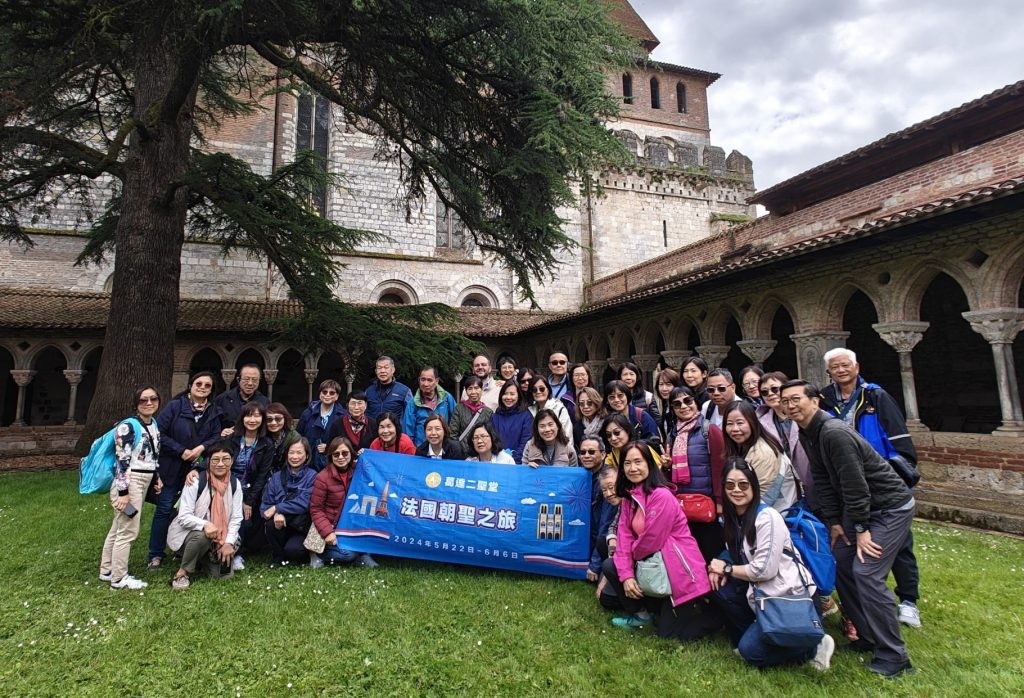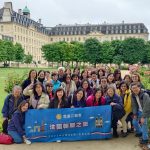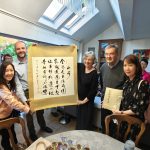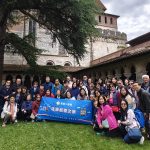
Père Matthieu Masson et pèlerins chinois en visite à Lisieux.
Organised by the Trinity team, the most dynamic of the 15 ‘Christian Base Communities’ in the parish, this pilgrimage was planned four years ago, but it was postponed because of Covid. As both a participant and a witness to these pilgrimages by Chinese people in France, I would like to tell you about some particularly significant moments. This is also a way of thanking those who maintain these communities and sanctuaries in France, which made it possible for us to have such a wonderful experience. Clearly, it was important to show them the best of the country and of the Church, and what was likely to please them. That wasn’t too difficult, as France is a very beautiful country, with delightful weather, neither too hot nor too cold. It felt like we had the air-conditioning outside! It is light early in the morning and late at night, and there are orange sunsets that last forever. We ate well, which is saying something for Chinese people. The country abounds in churches, its landscapes are magnificent, and there are good motorways. Apart from those in Paris, sanctuaries are accessible, both in small towns and in gorgeous, well-maintained villages, and it’s in these kinds of places that we spent most of our time.
Our first visit was to Lisieux, which was totally rebuilt after the war. It’s not a beautiful city, but the shrine, which organises reception in the different locations associated with the memory of Saint Thérèse, has such a sense of its mission and provides such a warm welcome that it makes it beautiful. In the Carmel, the cathedral, in Buissonets and the basilica, Ms Panontin gave us an introduction to the spiritual life of Saint Thérèse. In the evening, at the Hermitage, we took time to tell each other for whom and for what we wanted to pray during these two weeks. The most common intentions were for peace, good health and for the young. There was, as always, this great gap in our prayers between very general intentions for the world, and those for ourselves and for a few loved ones who were experiencing difficulties in life. We then carried these intentions into our rosaries, prayers and daily Mass.
After Lisieux, I was a bit apprehensive about crossing the Normandy Bridge, because the agency guide was sure to invite us to admire it. Since there is a much larger one in Hong Kong and we also pass by three or four such bridges to get to Zhuhai, they might not be very impressed. So I took the lead by explaining that there were, of course, larger bridges in China, but that this one was not bad either, and that the French were very proud of it. They found it very pretty, and it is true that it is beautiful.
Sunday Mass
In preparing for this pilgrimage, we paid particular attention to where we would be on Sundays, so that we could join Sunday Mass in French, and so that the participants could see how that works. The liturgy of the Catholic Church in France has, in fact, certain unique features that I learned were specifically French only after having lived abroad for a while. The most obvious and disconcerting is that, during Mass, someone leads the hymns by standing in the choir, as if the congregation were a large choir. But a much more interesting feature is that of the profession of faith. It was in the splendid cathedral of Amiens that my parishioners were able to experience it for the first time. The fathers of the Saint-Martin community had spoken to me about it as something that could have been an issue for us, but, as it turned out, it was well received. As I had to explain the meaning of this ceremony, it seemed to me to be more obvious and more relevant than my earlier understanding, when I had experienced it from the inside. It is simply a matter, for young people who have been baptised as babies, of making a commitment to this baptism. My pilgrims recognised the elements of baptism: the cross, with which one is marked, either during the rite of welcoming catechumens, or at the beginning of the liturgy of the baptism of newborns; the profession of faith; and the complementary rites of the white garment and the light. They really liked it, and perhaps it will give them some ideas.
During the sermon, I saw the impressive cracks that run through the pillars of the south wall and the vaults of the nave. While assuming that competent people were concerned about them, and that they either thought they weren’t too serious or were considering ways to make this marvel stand for a few more centuries, I was happy to have seen it before it collapsed, and I meditated on things that pass.
An old baptistry
While visiting the cathedral, we noticed a very large and very old rectangular baptistry. We would have liked to understand better how it worked, that is to say, how the baptisms for which it was made took place. Unlike even older baptistries, as well as modern ones such as those in our Asian churches, it is not dug into the ground, but raised, so that the baptised person climbs up into it, rather than descending, as we descend into the death of Christ to rise again. This suggests that, in Amiens, it was more important that the baptism be seen by the congregation, unless it was raised for another reason that escaped us. In any case, it is this object that intrigued us the most, no doubt because the parishes of Hong Kong live from the great ceremonies of adult baptisms during the Easter Vigil. The fathers of Saint-Martin are therefore right to restore this baptistry to its former glory. Also, it seems that there was a record number of adult baptisms in France this year. Let’s hope it will be beaten next year.
After Amiens and Arras, we were welcomed at the Bouvines monastery by Mr. and Mrs. Ebin, from the Chemin-Neuf community. They let us stay not far from my parents’ house, where an evening visit was a much-anticipated moment for the participants. The Chinese way of being friendly is not quite the same as the French, and I had to give my parents some instructions. Above all, they had to stop serving and had to stand in the middle for a sort of ceremony during which they would receive the gifts that each of the pilgrims had prepared for them: Chinese calligraphy, Mongolian calligraphy, a Vietnamese Our Lady, an embroidered Our Lady, tea pots and teas, and even a bottle of cognac. My parishioners also wanted to see my twin brother, who is a priest like me, and who spent the next day with us. In reality, we have both always hated entertaining the gallery as twins. But, on this occasion, he cooperated fully with the whole photo procedure. With the Chinese, if you don’t take photos, it means that nothing actually happened.
The historic centres of the cities of northern France, such as Arras or Lille, are made up of rows of similar houses. You can also find belfries and churches there, but no palaces. These rows of houses reflect the earlier political structure of these cities that had no aristocracy, but instead had constitutions or charters, and for a long time were governed, almost democratically, by the equivalent of a council of aldermen. These were governments without history, or at least, they are governments that the history books hardly mention, since the books are concerned mainly with kings, emperors and dictators. Nevertheless, this political system existed, and it functioned until well into the 15th century, when the ruling families of Europe fought over these cities, conquered them, and in so doing drew the outlines of countries that would become nations. Lille has only been French since 1668, before that it belonged to the Spanish and, even before that, the people of Lille did not feel they belonged to any nation. In some ways, this history echoed the more recent history of Hong Kong.
Bouvines Church
Since we were not that far away, we also visited the church of Bouvines. Its stained-glass windows, dating from the end of the 19th century, tell the story of the battle of 1214, as if it had been a war between European nations. We saw Philip Augustus mobilising the French against the Germans, the Flemish and the English, and winning the battle by the judgment of God. It is hardly surprising that, shortly after telling the story in this way, the First World War began. We also saw, later in our pilgrimage, the cathedral of Orléans, all decked out with banners that must undoubtedly have belonged to one pretender or another. The stained-glass windows, which tell the story of Joan of Arc, are from the same period and in the same vein as those in Bouvines. Clearly, these scenes of national mobilisations and wars are not very Christian, and seeing them in churches caused some embarrassment to my pilgrims. To get out of this mood, we sang the prayer attributed to Saint Francis: ‘Lord, make me an instrument of Thy peace’. One of the aims of the pilgrimage was to tell the story of the life and religious vocation of Bernadette Soubirous, whom I love very much. So we went to Lourdes, Bartrès and Nevers. In Bartrès, where Bernadette got bored looking after sheep, when she would have preferred to go to catechism and have her first communion, there now live an Italian sister and two Malagasy sisters who have just taken over the reception at ‘La Pastourelle’. I had not managed to contact them before, so we went there hoping that things would get sorted out on site. I heard someone vacuuming behind the door, I rang the bell and apologised for arriving unannounced, to which the nun apologised even louder than I had and immediately made herself available to welcome us and tell Bernadette’s story. Thanks to her, we had a wonderful day in Bartrès. One of the charms of this place is that it is peaceful. But I am surprised that it is not more frequented by pilgrims from Lourdes.
The sanctuary at Rocamadour
The welcome at Rocamadour sanctuary from Father Florent Milet was as warm as our reception in Bartrès. For this second Sunday of our pilgrimage, we were able to join a fairly large Sunday Mass, which gave the pilgrims another beautiful impression of the life of the Church in France. For this Mass there was a small choir of eight people singing in four parts. As we use polyphony very little in Hong Kong, and we judge a choir more by the number of its choristers, my pilgrims were very impressed by such quality of singing with so few singers. The Mass was followed by a procession of the Blessed Sacrament accompanied by a children’s choir throwing flower petals on the path, which was, for my pilgrims, another memorable moment.
There were others, notably in Vézelay, with the Monastic Fraternities of Jerusalem. We were supposed to conclude the pilgrimage in Montmartre before going to the airport, but Paris is complicated, and the traffic jams dissuaded us. Finally, the end of our pilgrimage was saved by the parish of the Saint-Louis Cathedral of Versailles, which, unexpectedly, kindly opened its doors to us for Holy Communion. Thank you!
Fr. Matthieu Masson, MEP
- Le groupe des pèlerins chinois avec le père Matthieu Masson dans le jardin des Missions Etrangères de Paris.
- Accueil des pèlerins chinois dans une famille française avec le père Matthieu Masson.
- Les pèlerins chinois en pèlerinage en France, en visite à Rouen.
- Père Matthieu Masson et pèlerins chinois en visite à Lisieux.



